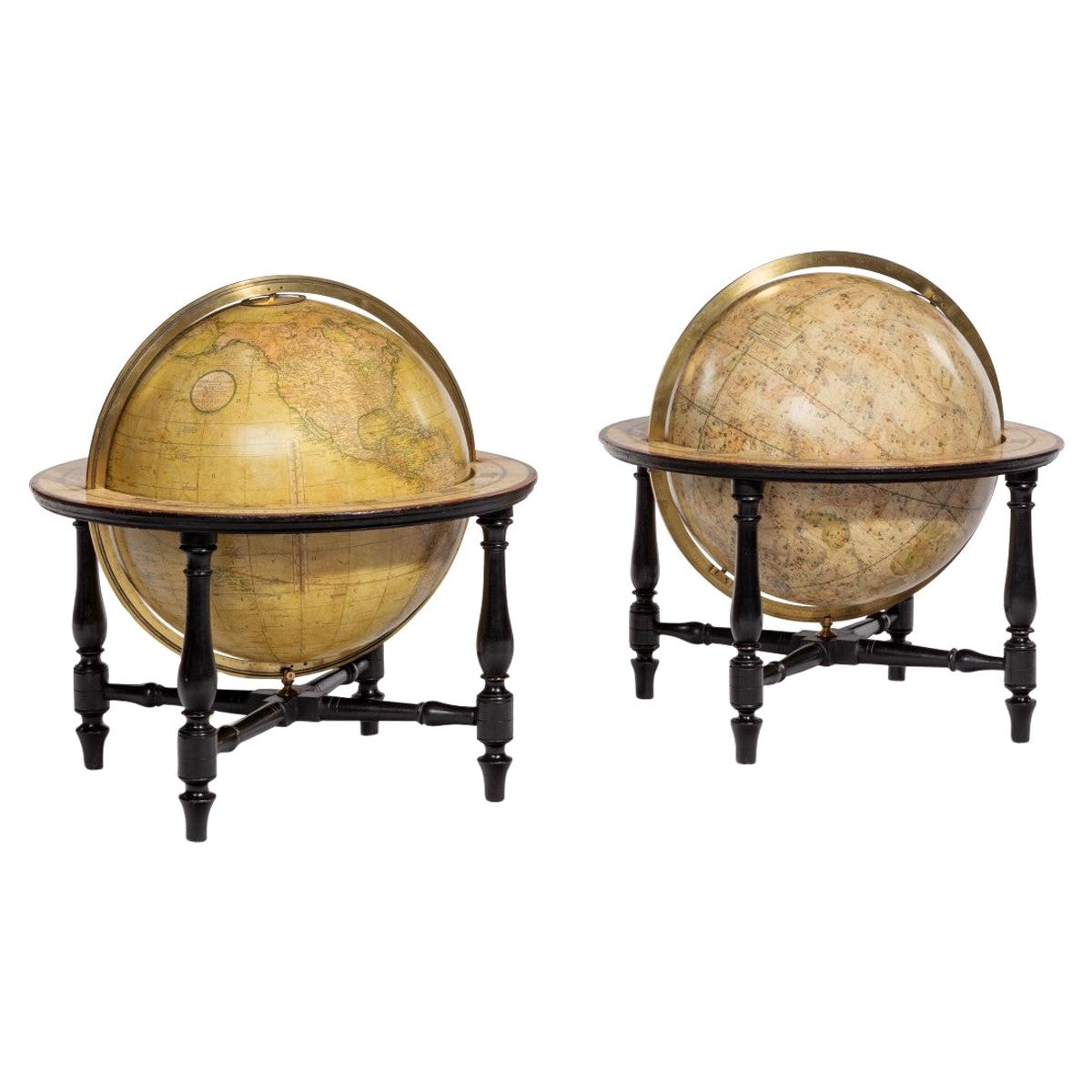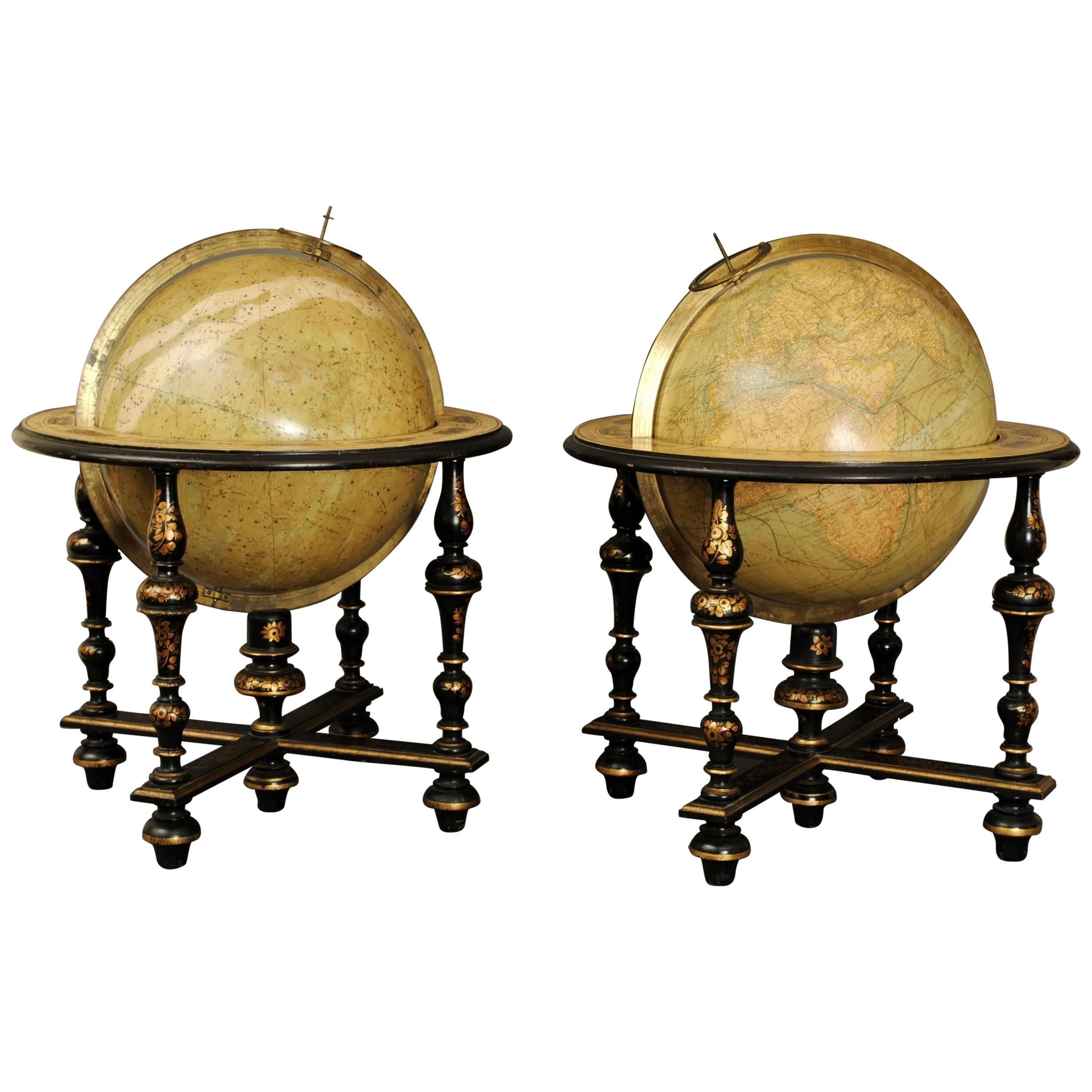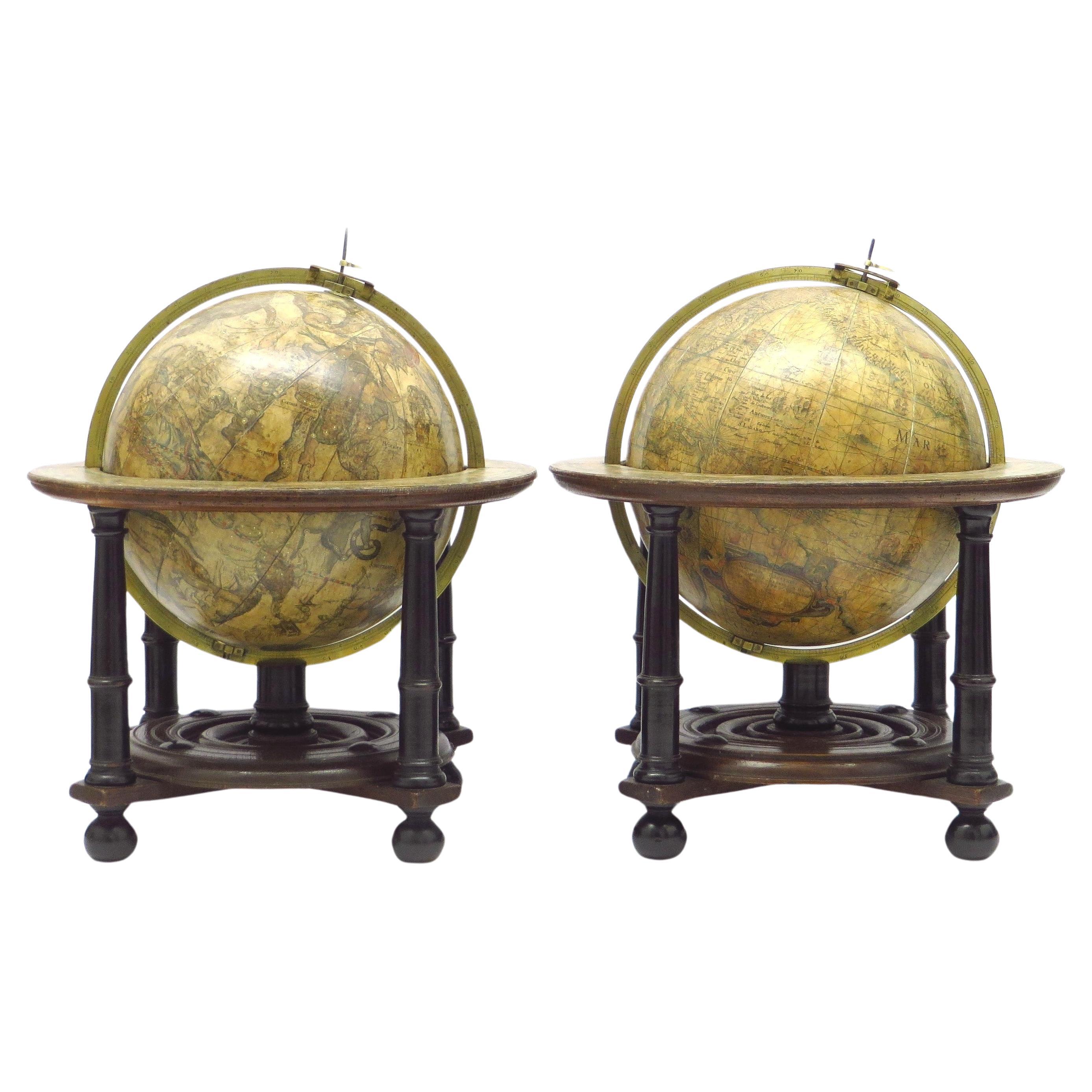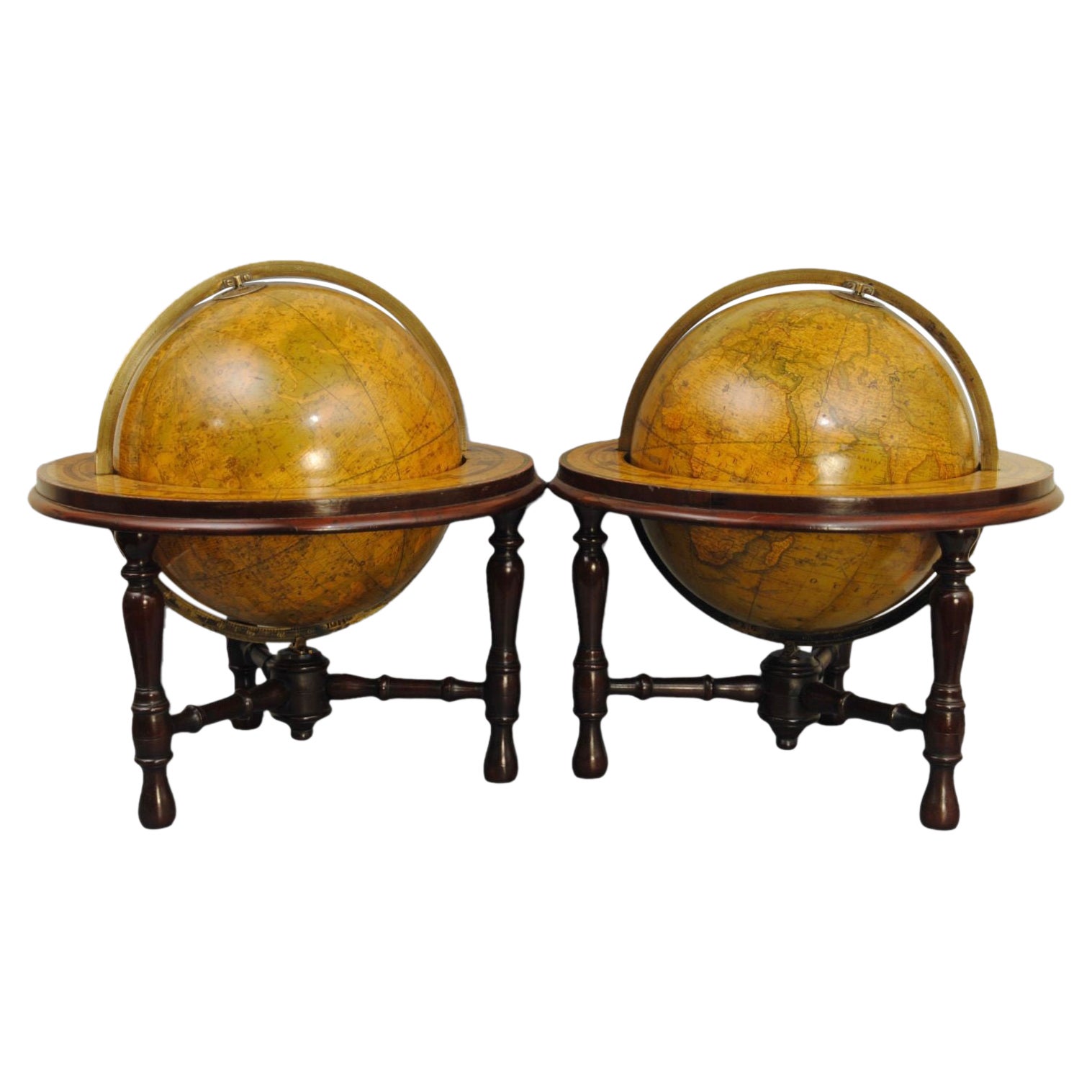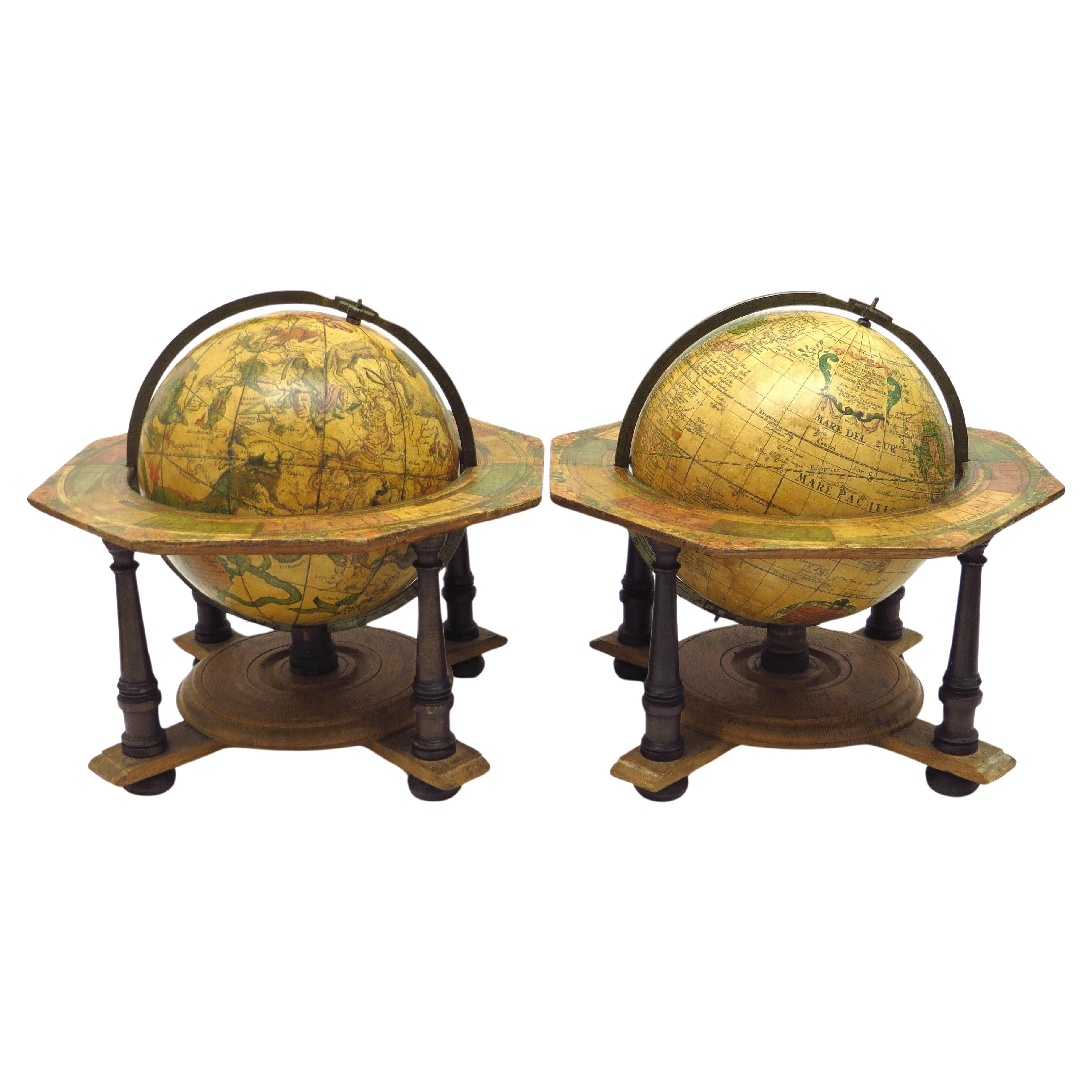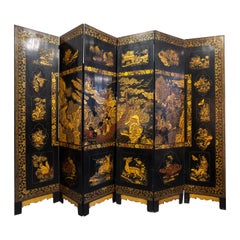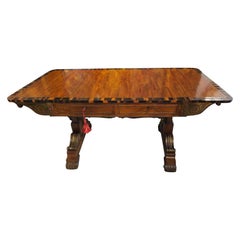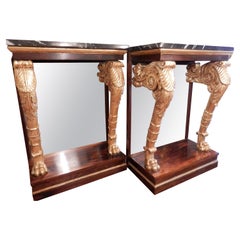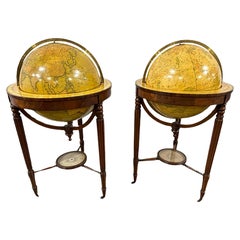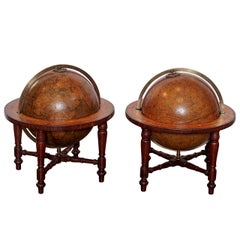
Pair of Important G.F Cruchley's Table Top Globes
View Similar Items
Want more images or videos?
Request additional images or videos from the seller
1 of 11
Pair of Important G.F Cruchley's Table Top Globes
About the Item
- Sold As:Set of 2
- Style:Late Victorian (Of the Period)
- Materials and Techniques:
- Place of Origin:
- Period:
- Date of Manufacture:1860
- Condition:
- Seller Location:Dallas, TX
- Reference Number:1stDibs: 1410088732484
About the Seller
5.0
Vetted Seller
These experienced sellers undergo a comprehensive evaluation by our team of in-house experts.
Established in 1986
1stDibs seller since 2009
70 sales on 1stDibs
More From This SellerView All
- Fine 19th C English Black Lacquered and Raised 6 Panel Screen Greek KeyLocated in Dallas, TXA fine 19th century English black lacquered Chinoiserie decorated 6 panel screen. Greek key design with scenes of figures and animals. Raised detail.Category
Antique Late 19th Century English Chinoiserie Screens and Room Dividers
MaterialsLacquer
- Important Regency Sofa Table by George Smith, Gillows London, Exotic WoodsBy George SmithLocated in Dallas, TXA regency brass inlaid and gilt bronze mounted exotic wood sofa table Gillows, designed by George Smith, circa 1810 Measures: Height 28 3/4in (73cm); width closed 39in (99.1cm); width open 61 1/2in (156.2cm); depth 31 3/4in (80.6cm) Footnotes: Literature Smith, George. A Collection of Designs for Household Furniture...Category
Antique Early 19th Century English Regency Game Tables
MaterialsBrass
- A fine pair of Regency rosewood and parcel gilt marble top consolesLocated in Dallas, TXA fine pair of Regency rosewood and parcel gilt carved consoles with marble tops . Mirrored backs . Fine qualityCategory
Antique Early 19th Century English Regency Console Tables
MaterialsRosewood
- A fine pair of 19th century Charles X mahogany and marble top commodes.Located in Dallas, TXA fine pair of 19th century Charles X period mahogany and Verde marble topped commodes . Original locks and keys. Hand carved and French polishedCategory
Antique Early 19th Century French Charles X Commodes and Chests of Drawers
MaterialsMahogany
- Fine Set of Important 12 19th Century English Chippendale Mahogany Dining ChairsLocated in Dallas, TXA very Fine set of 12 19th century English finely carved mahogany dining chairs. Finely detailed and carved. Heavy and well made. Two arms and ten sides.Category
Antique Late 19th Century English Chippendale Dining Room Chairs
MaterialsMahogany
- Fine Pair of 19th Italian Louis XV Mahogany and Inlayed Marble Top NightstandsLocated in Dallas, TXA fine pair of late 19th century Italian Louis XV mahogany and satinwood inlayed marble top nightstand commodes. Gilt bronze details.Category
Antique Late 19th Century Italian Louis XV Commodes and Chests of Drawers
MaterialsMahogany
You May Also Like
- A huge pair of 21 inches Cruchley Library GlobesBy G.F. CruchleyLocated in ZWIJNDRECHT, NLG.F. Cruchley (UK, 1796-1880) London ca 1850 A magnificent pair of terrestrial and celestial globes. Equatorial table engraved with the signs of the zodiac and resting on 3 mahogany molded feet held by a compass at the spacer. With graduated brass meridian circles and time clocks. The terrestrial globe is inscribed in a cartouche: Cruchley's new terrestrial globe from the most recent and best authorities. Exhibiting the discoveries in equatorial Africa, north pole. And the new settlements and divisions in Australia, New Zealand, Californa, Texas, &c. London. Sold by Gould and Porter opticians 181 strand WC. The celestial globe is inscribed in a cartouche: Cruchleys new celestial globe on which is accurately laid down the whole of the stars and nebule contained in the astronomical catalogue of the Reverend Mr. Wollaston F.R.S. Also from the authorities Flamstead, De La Caille, Hevellus, Bradley, Herschel, Maskelyne, &c. Ands the limits of each constellation determined by a boundary line. London, published by G.F. Cruchley, map-seller & globe maker, 81 Fleet street. Signed: CRUCHLEY in London England, circa 1850 H. 125 cm Diam. 53 cm (21 inches) Diam. 25 cm compasses The two spheres are in a perfect state of freshness and are perfectly legible. The condition of both the globes is very good. There have been some professional repairs to some damaged gores. The Terrestrial globe in good conserved and legible condition, it has areas of rubbing, retouching, and slight discoloration. The Celestial globe is also in good conserved and legible condition with areas of rubbing, retouching and slight discoloration. The gores themselves have been cleaned and revarnished. The splendid mahogany legs and moulded feet are in first class condition. Each globe consists of 12 hand coloured copper engraved gores over a paper-maché hollow core, made up of two hemispheres joined at the equator and covered with a layer of plaster. There are paper horizon rings, made up of a series of concentric circles, displaying the months of the year, the signs of the zodiac and wind directions. THE TERRESTRIAL GLOBE. The globe provides much detailed information, and was accurate up to the date of production, which in this case is the mid-19th century. It shows the latest discoveries and developments that had taken place. It displays names and territories that were once familiar to the people of the age, 150 years into the future! In Asia for example, there are places like ‘Little Bucharia’, ‘Little and Greater Tartary’, ‘Russia in Asia.’ Undoubtedly, the continent that has changed more than any other is Africa. So many African countries that we know and recognise now, had different, perhaps more ‘Colonial’ names more than a century and a half ago. There was ‘Nubia’ (Sudan/Egypt), ‘Abbyssinia’ (Ethiopia), ‘Cape Colony’ (South Africa), ‘Dahomey’ (Benin) but to name a few. Australia was a little over 50 years away from its union via ‘Federation’ in 1901. This brought about the Commonwealth of Australia. However, in 1850 they were six separate British selfserving colonies, ruled directly from England. In North America, both Los Angeles and San Francisco are incorporated as cities into California - as it becomes the 31st U.S. state. Much of mid-western and western USA were known as ‘The Western Territory’ & ‘The Missouri Territory’, Florida was still refered to as ‘East & West Florida’. Canada was split into ‘Canada East’ & ‘Canada West.’ Canada East was primarily (for historical reasons) French-speaking, and Canada West primarily Englishspeaking. Much of Western Canada remained unexplored and undeveloped. In Europe, there was still the ‘Russian Empire’, the ‘Ottoman Empire’, the ‘AustroHungarian Empire’, and the German ‘Prussian Empire.’ THE CELESTIAL GLOBE. The Celestial Globe displays the stars, the constellations, clusters and nebulae in a beautiful and well thought out manner. Mythical figures and signs of the zodiac are seen. The equinoctial and solistitial colures are graduated in degrees. Although the colour is somewhat muted, it takes nothing away from the overall beauty and the undoubted aesthetic qualities of the globe. Historically, globes are among the most ancient scientific instruments known to man. They can be dated back over two millennia, and are still manufactured to this day. The earliest tradition of globe making is mainly concerned with celestial globes – man...Category
Antique 1850s British Victorian Globes
MaterialsOther
- Pair of 19th Century Cruchley Terrestrial Library Globes with CompassesBy G.F. CruchleyLocated in Dallas, TXA handsome set of collectable Mid 19th Century library Globes with compasses on castors. Created by George Fredrick Cruchley circa 1850. Compasses sit directly below the globes. Very...Category
Antique Mid-19th Century British Globes
MaterialsGlass, Wood
- Pair of Cary’s Table GlobesLocated in Lymington, HampshireA pair of Cary’s 15-inch table globes, each set into an ebony stand with four turned legs and stretchers, the terrestrial stating “Cary’s New Terrestrial Globe exhibiting the tracks ...Category
Antique Early 1800s English Globes
MaterialsEbony
$27,837 - Superb Pair of Delamarche Table GlobesLocated in Lincolnshire, GBA wonderful pair of 19th century table globes by Mansion Delamarche Paris, in superb original condition. The 12" globes in the original lacquered and gilt decorated stands.Category
Antique 1860s French Globes
$37,756 / set - A pair of extremely rare Valk table globesBy Gerard and Leonard ValkLocated in ZWIJNDRECHT, NLTitle on the globes: VALK, Gerard and Leonard. [Terrestrial globe:] Cosmotheore, caelesti nostro globo, par, et plane novus, hic terrestris ut existeret, certo scias, errore veterum ...Category
Antique 18th Century Dutch Dutch Colonial Globes
MaterialsOther
- An exceptional pair of BLAEU table globesBy Willem BlaeuLocated in ZWIJNDRECHT, NLA very rare set of globes, 9 inch / 23cm, with an overall height of 38 cm, Amsterdam, dated 1602, but published after 1621. In their original stands with circular wooden horizon rings, covered with printed paper, supported by four legs and brass meridian rings supported by a single column. The terrestrial and celestial globe are made up of a set of 12 engraved gores, heightened in gold and Arctic ice caps, printed on paper and mounted on a plaster sphere of papier maché. Each sphere is mounted in a graduated brass meridian ring with the production number stamped at the back of the ring. Both globes are mounted on four-legged ebonized oak Dutch stands, which support the horizon ring. The legs are connected by two crossbeams which support a circular base plate with central support for the meridian ring. The horizon rings are covered with printed paper. With usual defects: paper equinoctial tables present gaps that are filled and restored; small splits along gores; several partially deleted entries; on the globe, the date 1602 and the text of the cartouche in America, are illegible ; small scattered spots but in general in good condition for such an early globe pair of which presently only 19 pair are recorded. These 9-inch globes are among the rarest since very few copies of them are known to exist, in comparison with the smaller or larger globes of Blaeu (4, 6, 13.5, and 26 inches). Blaeu's terrestrial globes were highly valued and were much in demand, because of the care with which they had been prepared, because of the efforts to give the latest information on discoveries, and because of the loxodromic lines that made them of special value to navigators. His celestial globes were appreciated for the fact that he had been the pupil of Tycho Brahe, who was himself known to be the greatest astronomer of his time. Willem Janszoon Blaeu (1571–1638), originally trained in astronomy, he quickly became a leading maker of maps, atlases and instruments. Blaeu’s globes were luxury items for wealthy and intellectual merchants and nobility who benefited from Blaeu’s access through the Dutch East India Company to the latest navigational discoveries and geographical information. Willem Jansz Blaeu collected information that Dutch mariners gathered from around world and brought back to Amsterdam. Crews were instructed to record information about the lands they visited and the skies they saw. Blaeu incorporated these observations in maps and globes. Through his web of contacts and thanks to assiduous research, he was also able to obtain the most recent information about the latest discoveries in the western hemisphere and the South Pacific, where Dutch explorers were particularly active at the time. Since the globe was published after 1618, Blaeu was able to include the discoveries made by Henry Hudson in his attempt to find a passage to the East Indies. He also included recent Pacific discoveries of the celebrated voyages of Willem Cornelis Schouten and Jacob Le Maire, who both traversed the South Pacific and the Atlantic. The findings of Schouten and Le Maire in the Tierra del Fuego region are also incorporated. The Strait of Le Maire is drawn and the hypothetical southern continent is labelled “Terra Australis Incognita Magalanica”. Olivier van Noort’s track is drawn and labelled. His route is indicated with a broken line and the words: “Navigationis Olivierij ductus” (several times). There are various decorative features, such as animals on the different continents, many ships on the high seas and allegorical and mythical figures around the cartouches. The nine-inch globe is not just a smaller version of the one published in 1599. Drawings of animals and people do often correspond to those on the earlier globe, but Blaeu made several significant changes. - The west coast of North America is drawn differently and the river system of Brazil is altered. - The hypothetical southern continent is labelled: Terra Australis Incognita Magallanica. - There are nine ocean names in handsome curling letters: Mare Congelatum, Mare Atlanticum, Oceanus Aethiopicus, Mare Arabicum et Indicum, Mare di India, Oceanus Chinensis, Mar del Zur, Mare Pacificum, Mar del Nort. - Willem Blaeu...Category
Antique 17th Century European Dutch Colonial Globes
MaterialsOther
Recently Viewed
View AllMore Ways To Browse
Table Top Used
Antique Table Top
Antique Victorian Home
Antique Accent Table
Antique Accent Tables
Accent Table Antique
Antique Accent Table Furniture
Antique Accent Tables Furniture
Accent Tables Of Brass
Accent Tables Pair
Pair Of Accent Table
Antique Wood Accent Table
Victorian F
Antique Brass Accent Table
Table Top Globe
Celestial Globes
Celestial Globe
Celestial Table


